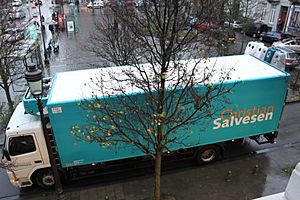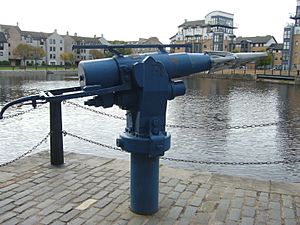Christian Salvesen facts for kids
 |
|
| Industry | Whaling Transport Logistics |
|---|---|
| Fate | Merged with Norbert Dentressangle |
| Successor | Norbert Dentressangle |
| Founded | 1872 |
| Defunct | December 2007 |
| Headquarters | Edinburgh, Scotland, UK |
|
Key people
|
Christian Salvesen (founder) |
| Parent | Norbert Dentressangle |
Christian Salvesen was a Scottish company with a long and interesting history. It started with whaling, then moved into transport and logistics. At its peak, it had 13,000 employees and worked in seven countries across western Europe. In December 2007, a French transport group called Norbert Dentressangle bought the company.
Contents
History of Christian Salvesen
Christian Salvesen (1827–1911) was born in Mandal, Norway. His father, Thomas Salvesen, was a shipowner. In 1846, Christian's older brother, Johan Theodor Salvesen, started a business called Turnbull, Salvesen and Company in Leith, Scotland. Leith is a port town near Edinburgh.
Christian Salvesen joined the company in 1851 after moving from Norway. He lived and worked in Leith. In 1868, Christian Salvesen also helped start a mining company in Norway.
In 1872, Christian Salvesen left the first company and started his own: Christian Salvesen & Co. It was based in Leith.
Early Business Ventures
At first, Christian Salvesen & Co. helped ships with their cargo and acted as shipbrokers (people who arrange deals for ships). They also traded timber. In the 1880s, the company started buying its own steamships. By 1886, they had a shipping route to Stavanger in Norway, with stops along the Norwegian coast.
In 1883, Christian Salvesen's oldest sons, Thomas and Frederick, took over the shipping side of the business. In the early 1900s, the company became very involved in whaling. They first hunted whales in the Arctic and then in the Antarctic.
They set up a whaling station called Leith Harbour on South Georgia Island, near the Falkland Islands. This station was named after their base in Scotland. In 1908, Christian Salvesen also helped build Norway's first electric railway. This railway supported their mining interests.
Whaling Ships and Legacy
From 1950 to 1962, the company owned two large whaling ships: the Southern Harvester and the Southern Venturer. These were like floating factories that processed whales. Each whaling trip included these factory ships and smaller "whale catchers." Some catchers even had helicopters to spot whales!
One of their whale catchers, the Southern Actor, is now a museum ship in Sandefjord, Norway. You can visit it to learn about whaling history. Christian Salvesen stopped whaling in 1963. They also stopped their shipping business in 1990. After that, they focused mainly on road transport.
Later Business Changes
After World War II, the whaling industry slowed down. Salvesen then moved into other areas. They bought a cold store (a large refrigerated warehouse) in Grimsby and got involved in housebuilding, freezing food, and oil. Later, they returned to the transport business by buying a company called Swift Services.
Christian Salvesen's home in Edinburgh was a large villa built around 1865. It was taken down in the 1960s. His offices in Leith also served as the Norwegian Consulate for Edinburgh. Christian Salvesen is buried in Rosebank Cemetery in Leith.
The Salvesen Family
Christian Salvesen was married to Amalie Georgine Salome Andorsen. They had several children, including Edward Theodore Salvesen (who became Lord Salvesen) and Theodore Salvesen. Their grandchildren included Harold Salvesen.
Helping Others (Philanthropy)
The Salvesen family was known for its generosity. Christian Salvesen's whaling ships brought the first penguins to Edinburgh. He donated them to Edinburgh Zoo, making it the first zoo in the world to have and breed penguins!
During World War I, the Salvesen family lost many sons and nephews. Because of this, they built several housing developments to honor those who served. These included:
- Earl Haig Gardens (1925) in Edinburgh, Scotland. This housing was for injured and retired army personnel. Memorial plaques over the doors remember Salvesen family members and others who died in the war.
- Salvesen Gardens (1948) in Muirhouse, Edinburgh, also for army personnel.
- Salvesen Crescent in Muirhouse, built for retired lighthouse keepers. Lighthouse keepers were very important for the safety of the Salvesen shipping fleet.
After Whaling: Focus on Logistics
After leaving the whaling industry in 1963, Christian Salvesen completely changed its focus. It became a major European company for transport and logistics (managing how goods are moved and stored).
In 1985, the company became a public company, meaning its shares could be bought and sold on the stock market. At this time, they had many different businesses, including shipping, making bricks, building houses, cold storage, and even renting out lighting for rock and roll concerts!
As a public company, Christian Salvesen decided to focus mainly on European logistics. They sold off their other businesses.
Company Changes and Takeovers
The company faced some challenges in the 1990s. In 1996, another company, Hays plc, considered buying Christian Salvesen, but the deal didn't happen. This led to Christian Salvesen spinning off (creating a separate company from) its generator rental business, Aggreko, in 1997.
Over the next few years, there were more talks about other companies buying Christian Salvesen, but no deals were made. Finally, on October 2, 2007, the company's board recommended that Norbert Dentressangle buy Christian Salvesen for £254.4 million. The takeover was completed on December 14, 2007.
See also
- Chr. Salvesen & Chr. Thams's Communications Aktieselskab
- The Memoir Club – Robin Salvesen Memoir, Ship's Husband
- Salvesen Archive at Edinburgh University Library catalogue entry
Other sources
- Somner, Graeme (1984) From 70 North to 70 South: A history of the Christian Salvesen fleet (Christian Salvesen Ltd) ISBN: 978-0-9509199-0-4
- Elliot, Gerald (1998) Whaling Enterprise: Salvesen in the Antarctic (Michael Russell Publishing Ltd) ISBN: 978-0-85955-241-7
- Salvesen, Edward Theodore (1949) Memoirs of Lord Salvesen (W. & R. Chambers)
- Watson, Nigel (1996) The story of Christian Salvesen, 1846-1996 (London: James & James Ltd.)
- Vamplew, Wray (1975) Salvesen of Leith (Scottish Academic Press) ISBN: 0-7011-2037-1




